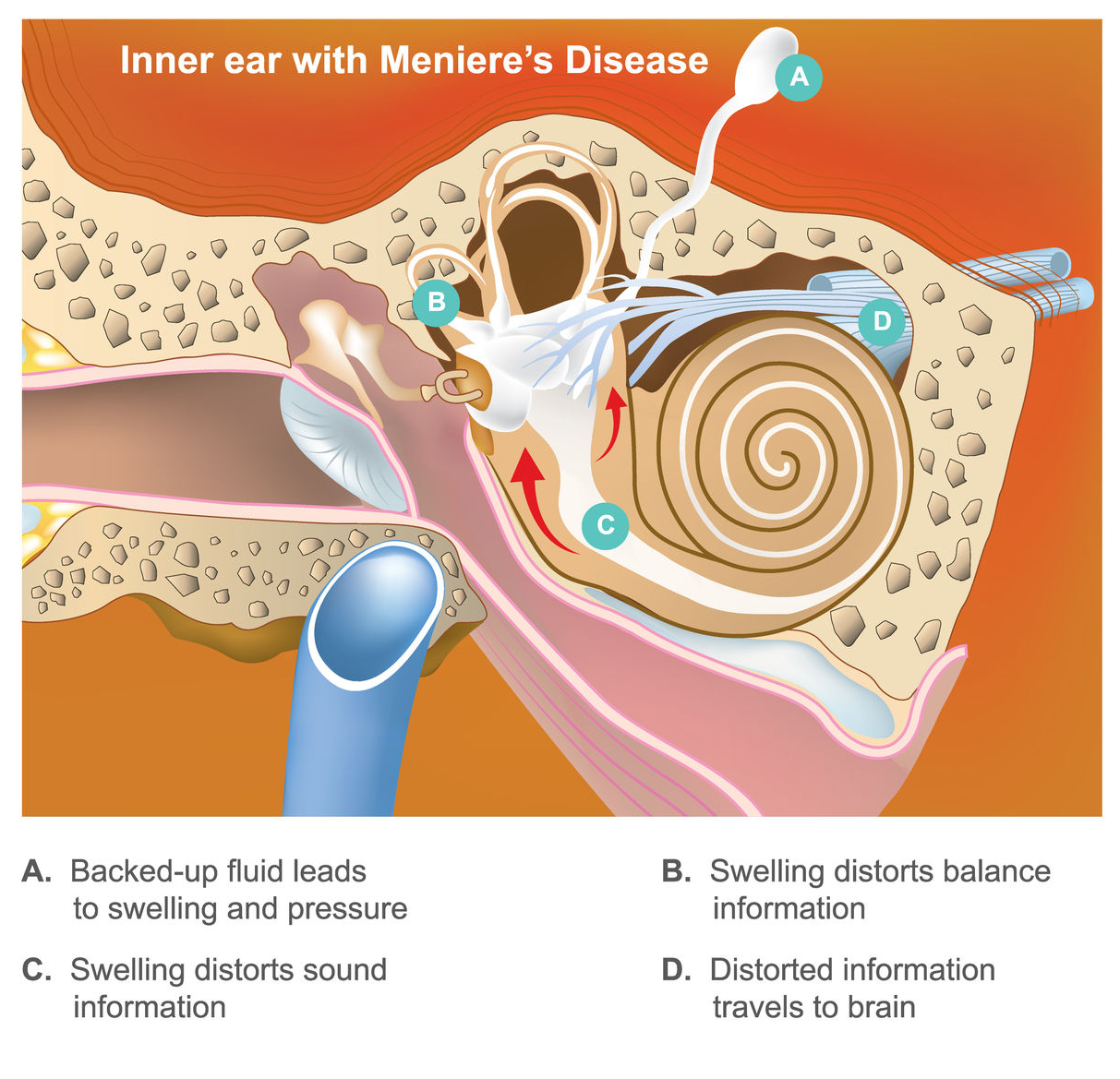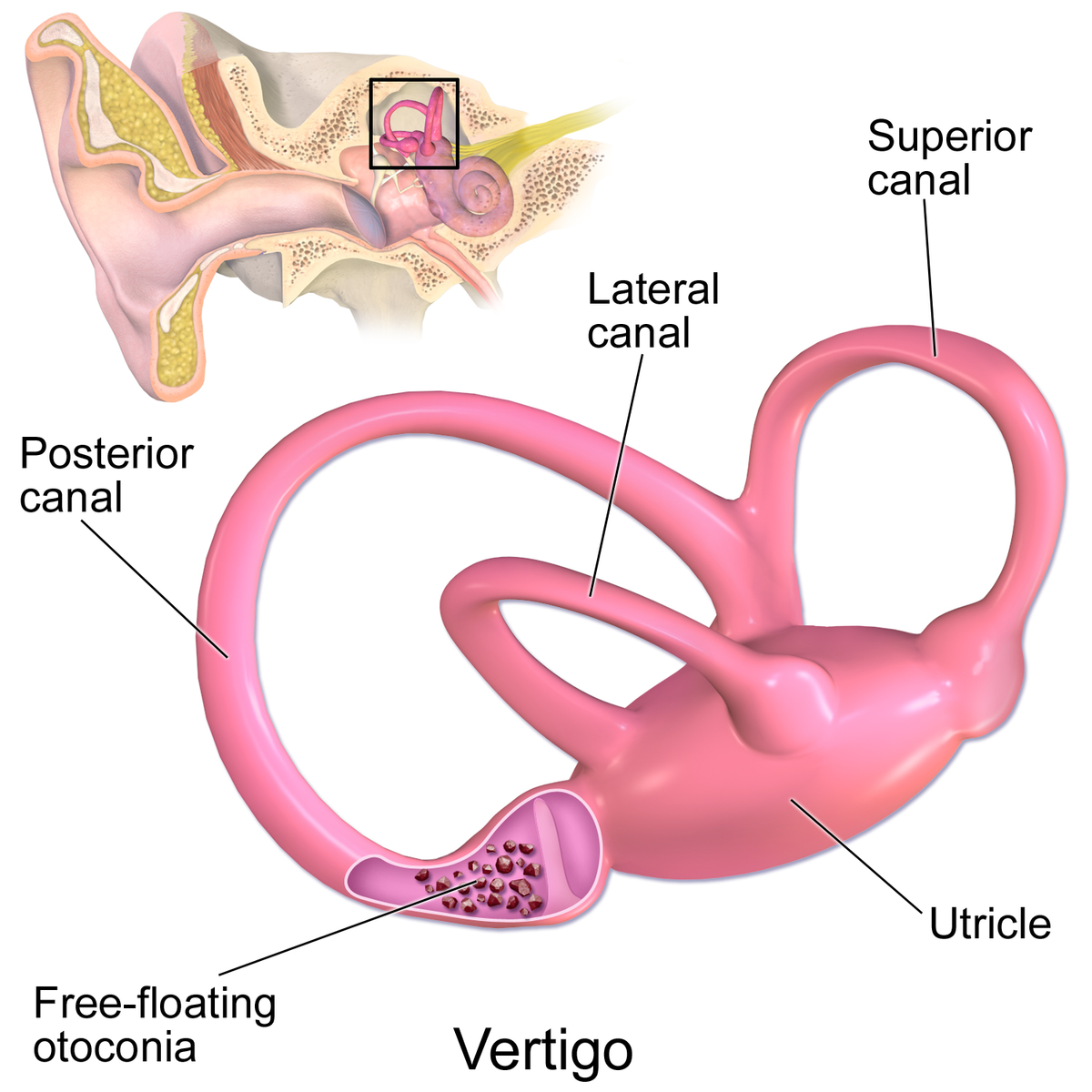Difference Between Meniere’s Disease and Vertigo
Meniere’s disease is a disease of the inner ear, characterized by increased production of labyrinthine fluid and an increase in intralabyrinthine pressure. Vertigo is the feeling that the environment is rotating around you or the feeling of pulling to one side. The key difference between Meniere’s disease and vertigo is that the Meniere’s disease is а pathological condition, while the vertigo is not a disease, but a symptom. Vertigo appears as a symptom in Meniere’s disease.

What is Meniere’s Disease?
Meniere’s disease is a disease of the inner ear, characterized by increased production of labyrinthine fluid and an increase in intralabyrinthine pressure, resulting in attacks of progressive deafness, tinnitus, and vertigo, accompanied by vegetative disorders (nausea, vomiting). The severity and frequency of seizures may decrease over time, but hearing impairments are always progressive.
There are several forms of the disease:
- Classic form – a simultaneous violation of auditory and vestibular functions (30% of the cases);
- Cochlear form – begins with hearing disorders (50% of the cases);
- Vestibular form – begins with vestibular disorders (15-20% of the cases).
Meniere’s disease affects all ages, but the average age of the patients is between 20 and 50 years. The disease is more common in residents of large cities and people engaged in intellectual work.
The exact etiology of Meniere’s disease is controversial. Theories are linking its onset with reactions of the inner ear to allergies, endocrine diseases, vascular diseases, viral diseases, syphilis, etc.
The symptoms of Meniere’s disease include a paroxysmal course of the disease, gradual deterioration of hearing, spontaneous attacks of vertigo lasting from 20 minutes to several hours, tinnitus. Severe attacks of Meniere’s disease are characterized by nausea and vomiting, heavy sweating, low body temperature, and loss of balance. The intensity of the symptoms increases with movement.
The diagnosis of Meniere’s disease is made by an ENT specialist, based on examination and medical history. Laboratory tests are performed to exclude other diseases with similar manifestations, including:
- Examination of the thyroid gland;
- Otoscopy (direct observation of the tympanic membrane);
- Hearing examination;
- Examination of the vestibular apparatus;
- Magnetic resonance imaging to exclude neurinoma of the auditory nerve, etc.
Physical activity should be limited during seizures, but between them, it is recommended to maintain full physical activity. The medications prescribed during attack are atropine, diazepam, or scopolamine. In the periods between attacks the prescribed medications include meclozine, phenobarbital, diazepam, dimenhydrinate, promethazine, diphenhydramine, etc.

What is Vertigo?
Vertigo is the feeling that the environment is rotating around you or the feeling of staggering / pulling to one side. It is a common problem in medical practice.
Vertigo can be with peripheral (damage to the vestibular nerve and labyrinth) or central origin – due to diseases affecting the central nervous system. The central type of vertigo is due to abnormal transmission, processing, and perception of the nerve signal from the peripheral vestibular pathways (including the inner ear and vestibular nerve) to the central brain structures.
The most common causes of vertigo are:
- Sudden change in head position – causes a short-term benign paroxysmal positional vertigo (BPPV);
- Inflammation of the inner ear (acute vestibular neuritis) – causes severe dizziness with a sudden onset that lasts several days;
- Meniere’s disease – one of the symptoms is sudden episodes of vertigo that last from 30 minutes to several hours;
- Migraine – migraine can be accompanied by vertigo;
- Acoustic neuroma – a benign growth of the vestibular nerve, causing progressive hearing loss and tinnitus, accompanied by dizziness and loss of balance;
- In rare cases, vertigo can be a symptom of a much more serious problem such as stroke, cerebral hemorrhage, and multiple sclerosis.
The occurrence of vertigo is more typical in old age, due to increased risk factors – hypertension, atherosclerosis, diabetes, etc., and the corresponding increase in the risk of vascular complications. Among younger people, the appearance of a “central” type of vertigo is often associated with the presence of a migraine headache or demyelinating process.
Vertigo can be:
- Labyrinthine vertigo;
- Vestibular vertigo;
- Vertigo when the brain stem is affected.
The diagnosis of vertigo is made by:
- Thorough neurological examination;
- Electronystagmography and video nystagmography – to determine abnormal eye movements and balance in different positions of the head;
- Magnetic resonance;
- Audiometry;
- Vestibular evoked myogenic potentials;
- Computerized posturography.
Exercise is part of the general combination therapy for vertigo and for maximum effect it could be combined with appropriate medications. Depending on the cause of vertigo, it is recommended to take vasodilators, vasodilators, vitamin B-complex, preparations with Ginkgo biloba, etc.
Difference Between Meniere’s Disease and Vertigo
Definition
Meniere’s Disease: Meniere’s disease is a disease of the inner ear, characterized by increased production of labyrinthine fluid and an increase in intralabyrinthine pressure, resulting in attacks of progressive deafness, tinnitus, and vertigo, accompanied by vegetative disorders.
Vertigo: Vertigo is the feeling that the environment is rotating around you or the feeling of staggering / pulling to one side.
Types
Meniere’s Disease: The forms of Meniere’s disease are classic, cochlear, and vestibular Meniere’s disease.
Vertigo: Vertigo can be with peripheral or central origin.
Occurrence
Meniere’s Disease: Meniere’s disease affects all ages, but the average age of patients is between 20 and 50 years. The disease is more common in residents of large cities and people engaged in intellectual work.
Vertigo: The occurrence of vertigo is more typical in old age, due to increased risk factors – hypertension, atherosclerosis, diabetes, etc., and the corresponding increase in the risk of vascular complications.
Causes
Meniere’s Disease: The exact etiology of Meniere’s disease is controversial. Theories are linking its onset with reactions of the inner ear to allergies, endocrine diseases, vascular diseases, viral diseases, syphilis, etc.
Vertigo: The most common causes of vertigo are a sudden change in head position, inflammation of the inner ear, Meniere’s disease, migraine, acoustic neuroma.
Diagnosis
Meniere’s Disease: The diagnosis of Meniere’s disease is made by an ENT specialist. Laboratory tests are performed to exclude other diseases with similar manifestations.
Vertigo: The diagnosis of vertigo is made by neurological examination, electronystagmography and video nystagmography, magnetic resonance, audiometry, computerized posturography.
Treatment
Meniere’s Disease: The medications prescribed during attack are atropine, diazepam, or scopolamine. In the periods between attacks the prescribed medications include meclozine, phenobarbital or diazepam, dimenhydrinate, promethazine, diphenhydramine, etc.
Vertigo: The treatment of vertigo includes vestibular training and appropriate medications including vasodilators, vasodilators, vitamin B-complex, preparations with Ginkgo biloba, etc.
Meniere’s Disease Vs Vertigo

Summary of Meniere’s Disease Vs Vertigo
- Meniere’s disease is a disease of the inner ear, characterized by increased production of labyrinthine fluid and an increase in intralabyrinthine pressure, resulting in attacks of progressive deafness, tinnitus, and vertigo, accompanied by vegetative disorders.
- Vertigo is the feeling that the environment is rotating around you or the feeling of staggering / pulling to one side.
- The forms of the Meniere’s disease are classic, cochlear, and vestibular Meniere’s disease. Vertigo can be with peripheral or central origin.
- Meniere’s disease affects all ages, but the average age of patients is between 20 and 50 years. The occurrence of vertigo is more typical in old age.
- Theories are linking the onset of Menier’s disease to reactions of the inner ear to allergies, endocrine diseases, vascular diseases, viral diseases, syphilis, and others. The most common causes of vertigo are a sudden change in head position, inflammation of the inner ear, Meniere’s disease, migraine, acoustic neuroma, etc.
- The diagnosis of Meniere’s disease is made by an ENT specialist. Laboratory tests are performed to exclude other diseases with similar manifestations. The diagnosis of vertigo is made by neurological examination, electronystagmography and video nystagmography, magnetic resonance, audiometry, vestibular evoked myogenic potentials, computerized posturography.
- The medications prescribed during Meniere’s disease attack are atropine, diazepam, or scopolamine. In the periods between attacks the prescribed medications include meclozine, phenobarbital or diazepam, dimenhydrinate, promethazine, diphenhydramine, etc. The treatment of vertigo includes vestibular training and appropriate medications including vasodilators, vasodilators, vitamin B-complex, preparations with Ginkgo biloba, etc.
- Difference Between Gallstones and Cholecystitis - September 5, 2021
- Difference Between Constipation and Cramping - August 4, 2021
- Difference Between Whole Genome Sequencing and Microarray - May 6, 2021
Search DifferenceBetween.net :
Leave a Response
References :
[0]Foster, C. Overcoming Positional Vertigo Paperback. Boulder: Bull Publishing Company. 2019. Print.
[1]Knoblauch, M. Overcoming Meniere's: How changing your lifestyle can change your life. Huston: Kiremma Press. 2018. Print.
[2]Warrell, D., T. Cox, J. Firth. Oxford Textbооk of Medicine. Oxford: Oxford University Press. 2010. Print.
[3]Image credit: https://commons.wikimedia.org/wiki/File:Vertigo.png
[4]Image credit: https://www.healthyhearing.com/uploads/images/menieres2.jpg
